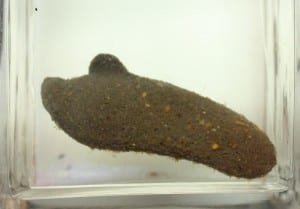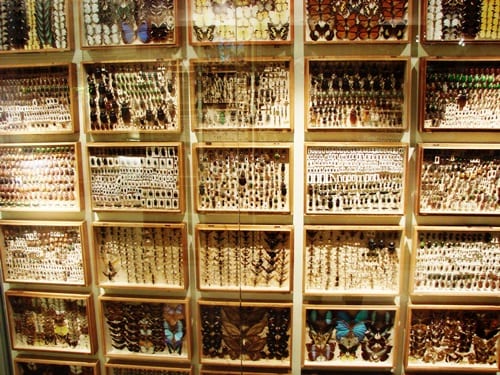Do some animals look too boring to be in a museum?
By Jack Ashby, on 22 March 2016
There is an underlying struggle in museum displays to fulfil two sets of needs. They have to do both to be successful:
- To engage the visitors’ interests, desires or questions that are sparked by their own experience of a topic, whether they come pre-armed with that experience, or whether they acquire it during their visit.
- For the museum to tell the stories that it has identified as the stories it exists to tell.
The struggle comes when a display meets one of these needs but not the other. This issue is the same in the worlds of politics and media – do we tell the people what they want to hear, or do we tell them what we want them to know?*
In natural history museums, we know that people like big animals, for example. Dinosaurs meet both needs above – people want to see them, and museums want to engage people in stories about them.
A chance to refresh our displays
At the moment are thinking about the displays around the wall of the Museum. 136 cabinets line the room. They were once book cases from when the room was the UCL Medical Library (we moved in in 2011). The motivation is that the ground-breaking QRator project has come to and end, so the nine cases associated with iPads need emptying. We have also uncovered 11 “new” cases above the entrance. This gives us the opportunity to rearrange at least some of the displays.
We think of our displays in similar ways to TV scheduling. “Primetime” equates to the row of displays at eye-height. The 3am “graveyard shift” matches to the top row of cases that are just below our balcony (they are far too high to be seen up close, so we design them to be like wallpaper – adding to the atmosphere but very light on content). The middle row of cases – above head height but low enough to see – is somewhere in between, but the “Daytime TV” analogy doesn’t quite fit.
Are sea squirts really primetime?
At the moment one of the “Primetime” cases is dedicated to sea squirts. Sea squirts are incredibly interesting as they are closely related to the vertebrates. Despite being amorphous cloudy blobs, they are far closer to us than more complex-looking animals like insects and squid. Their tadpole-like larvae have a notochord – the precursor to the vertebral column, which betrays their link to our group.
This is a really interesting story that completely fufils Need Number Two above – museums would love to tell this story. It could potentially spark a visitor to see humans (and other vertebrates) differently – this squidgy ball is your cousin.
But… is there any point in a museum display that nobody looks at?
The central concept of the story is that this small grey amorphous blob is – despite appearences – really interesting. The problem is, however, that unless people already know what they are, they look so boring that nobody stops to read about them because they don’t fulfil Need Number One. Small grey amorphous blobs don’t engage people.
The failure at Need Number One means that Need Number Two is irrelevant. What’s the point of displaying it – particularly in a “Primetime” slot – if we can’t get visitors to engage in their story?
A creative solution?
At the Grant Museum we developed a solution for a universal problem in museums – no-one had come up with a way to satisfactorily display the millions of microscope slides that are held in storage. The design of our Micrarium solved this problem – we tiled thousands of them together in a beautiful back-lit cave.
I wish we could come up with a equally creative way to make people want to look at sea squirts, but nothing is coming to me. Museums could unquestionably work harder to engage people in hard-to-display species.
Taxonomic injustice
There is no doubt that it is just plain wrong to exclude a taxonomic group from a museum because we haven’t been able to come up with a way of attracting people’s attention (I’m half tempted to encircle them in purple neon lights, but that seems a bit at odds with our Victorian atmosphere). But would we be better off telling more stories about a different set of specimens that visitors do want to engage in?
As wrong as it sounds/is, museum make decisions like these about displays all the time. Vertebrates make up just 2-3% of known species, but invertebrates probably make up a similar proportion of museum display space. The difference is that normally we don’t completely exclude a significant taxonomic group. Museums tend to give a tokenistic case of a few specimens from each notable groups.
Natural history museums are already deeply unrepresentative of nature – full of dinosaurs, whales and elephants, normally giving bugs and worms the occassional mini-display (another thing the Micrarium seeks to redress). There are exceptions, where museums have created stunning intertebrate-led exhibits to capture visitors imagination (there is a room at Exeter’s Royal Albert Memorial Museum tiled with butterflies), but they are always dwarfed by the space given to vertebrates.
This is completely understandable – museums need to display things that people want to look at. What I want to know is – would people miss the sea-squirts if they were put in store? It sounds like the wrong thing to do – taxonomic cleansing. Is it our responsibility to be comprehensive?
Who are we kidding – museums don’t display every taxon anyway. I’ve never seen a Xenoturbellid in a museum display.
Sea squirts are closer to the list of animals displayed in every museum, but are they definitely on it? What do you think – do some animals look too boring to be in a museum? #SaveTheSeaSquirts?
Jack Ashby is Manager of the Grant Museum of Zoology
*That all options require us to tell the truth is, of course, a given.
7 Responses to “Do some animals look too boring to be in a museum?”
- 1
-
2
Heidi Nicholl wrote on 23 March 2016:
I love what Roger said in his comment – I wonder if there’s scope for a one-off display of the sea squirts doing their beautiful thing with dyes and feeding currents? So, once people have engaged with them once they’ll seek out (and pass on) the story of the preserved specimen in the future. Time for a collaboration with an aquarium perhaps? The ability to relate to creatures in real life counts for a lot (e.g. how we respond to mummies, but also dinosaurs) so maybe re-linking the pots of pickled things to their real-life abilities would help?
-
3
Casey wrote on 28 March 2016:
The trick here is to make the display interesting enough from a distance to draw their attention. People may not have much visual interest in sea squirts, but other humans tend to draw attention. Perhaps a diagram with a picture of a family tree with a sea squirt on it mixed among humans (exaggerating the relationship, yes, but also drawing attention to the sea squirts for one of the very reasons they are interesting to museum staff). Or make it a competition- “Can you guess what is more closely related to humans?” with boards that flip up, an iPad/technology game, or a worker running it.
-
4
Brad wrote on 4 April 2016:
Flashing signs saying “Not Boring”, “Read Me”, and a big pointy arrow?
I’m serious
-
5
Andrew4040@hotmail.com wrote on 1 June 2016:
Hi,
Please reconsider taking sea squirts off display and placing them into storage!A really excellent way of displaying preserved samples of this type could be by placing the real preserved specimen alongside an incredible ‘Blaschka glass model’ of the same species!!!
I am guessing that you don’t have glass models to for all (or indeed many), of the real species that you have represented in collections at The Grant Museum, but a few representative displays would, I feel, help to fulfil both requirements.
I would dearly like to see more ‘Blaschka glass models’ on display at the Grant Museum and I suspect (if visitor numbers at Harvard’s ‘Glass flowers’ are anything to go by) that many more members of the public would like to see them too.
Many Thanks for the work that you all do – The Grant Museum of Zoology & Comparative Anatomy is a wonderfully educational resource and an incredibly beautiful collection.
See you on Saturday………..
-
6
Andrew Taylor wrote on 1 June 2016:
Hi,
Please reconsider taking sea squirts off display and placing them into storage!A really excellent way of displaying preserved samples of this type could be by placing the real preserved specimen alongside an incredible ‘Blaschka glass model’ of the same species!!!
I am guessing that you don’t have glass models to for all (or indeed many), of the real species that you have represented in collections at The Grant Museum, but a few representative displays would, I feel, help to fulfil both requirements.
I would dearly like to see more ‘Blaschka glass models’ on display at the Grant Museum and I suspect (if visitor numbers at Harvard’s ‘Glass flowers’ are anything to go by) that many more members of the public would like to see them too.
Many Thanks for the work that you all do – The Grant Museum of Zoology & Comparative Anatomy is a wonderfully educational resource and an incredibly beautiful collection.
See you on Saturday………..
 Close
Close





Sea squirts over dinosaurs for me any time. Dinosaur skeletons are impressive and it is not too difficult to imagine how dinosaurs must have been in life (even before the efforts of artists’ re-creations, video films etc.) – http://www.rwotton.blogspot.com/2014/10/our-fascination-with-dinosaurs.html.
Sea squirts are amazing live, especially when one uses dyes, or streams of particles, to observe their feeding currents. Perhaps one needs to point out that they are our “close relatives” (as you did in the blog post) and then pose questions about how they feed, and on what? Unfortunately, museums contain mainly preserved material and we have lost the ability to ask questions about the specimens we observe. It’s a challenge for museums and for those that visit them. Fortunately, the Grant Museum retains the charm, and fascination, of a Nineteenth Century collection – a time when “what’s that?” questions came naturally.